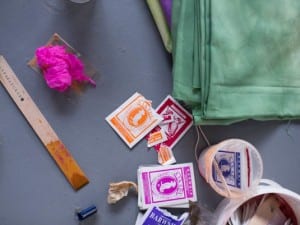Margeaux Walter (b. 1982) is a fine art photographer based in Joshua Tree, California, who explores conservation, climate change, consumption and waste. She invites viewers to engage with the practice of seeing, challenging not only what we see, but how we see. In Don’t Be a Square (2021-2023), she sets up site-specific interventions in the landscape – such as figures, curtains and even a juice bar – that disrupt the natural scenery. For Walter, the Anthropocene is a glitch in time and a fleeting moment yet one that has caused disproportionate havoc. Here, we learn more about about her location choices, the story behind her piece titled Juice Bar and how her work seeks to reunite viewers with their environments.

A: From lush foliage to desert expanses, Don’t Be a Square features a variety of landscapes. How did you select the locations for each shot?
MW: I initially started the project in Joshua Tree, California. I was seeking out landscapes that were at the forefront of climate discussions. The Joshua Tree itself is the first plant species to gain protection close to that of an endangered species, and so I wanted to come out here and experience not only how climate change has affected these trees but also the entire ecosystem. As the project expanded, I travelled to other areas with various ecological concerns such as rising tides, flooding, drought, and excess heat. The locations were selected based on this research as well as my access to them.
A: Could you tell us more about the piece Juice Bar?
MW: Whilst running one morning, I noticed that the mountains turn bright orange for about 5 minutes at the moment the sun first rises in the morning. I was blown away by this and how they almost looked on fire. I chose the build a juice bar for that location because I wanted to relate to the colours as well as bring an idea of commerce into the landscape. This is something we are famous for doing as a human race. I had to shoot this image several times, but on one morning I set up in the dark waiting for the sun, and noticed I had an audience of coyotes. They sat and watched the whole performance which was really beautiful. It was one of the only images I truly had an audience for.
A: Many of your projects explore the natural world. In what ways has your approach to this theme evolved over the years?
MW: My earlier work was more about consumer culture, which led to my interest in waste and plastics. As I spent more time learning about climate changes and specific problems, I became more interested in a fundamental disconnect that I see between people and the environment, a lot of which I think is influenced by technology and phone culture. I am now more focused on reuniting people with their environments through my images, by creating a new sense of interest and joy. That seems more important to me than focusing on specific detrimental behaviours.
A: Can you describe how it feels being in the running for the Aesthetica Art Prize?
MW: It feels very exciting that my images are seen, understood and appreciated in a way that matches my vision for them. Regardless of what happens, it is an honour to be a finalist for this award, I couldn’t be more grateful. It has helped me believe that I am on the right track with my work.

A: What are you working on now?
MW: I am working on a new series called Sedimental, in which I am focusing on simple modifications of the landscape through subtle hand-made interventions. The slow degradation of environments is not always noticeable until it’s too late, and it is this subtlety that I am interested in. To create these works, I have been photographing micro sections of the landscape, printing them onto fabric, and then sewing them into outfits and drapery. I then re-enter the landscape using my body cloaked in these prints, creating a new dialogue with the environment itself.
Walter will feature in the Aesthetica Art Prize 2024 Exhibition at York Art Gallery from 16 February – 21 April. Plus, meet over 250 longlisted international artists in our new online gallery.
Want to get involved? The next edition of the Prize is open for entries. Submit your work by 31 August. Win £10,000, exhibition and publication. Find out more here.
Image Credits:
- Margeaux Walter, Backstage (2022). From the series Don’t Be a Square (2021-2023). Duratran C-Type print. Lightboxes. LEDs.
- Margeaux Walter, Juice Bar (2022). From the series Don’t Be a Square (2021-2023). Duratran C-Type print. Lightboxes. LEDs.
- Margeaux Walter, Rise and Shine (2022). From the series Don’t Be a Square (2021-2023. Duratran C-Type print. Lightboxes. LEDs.





